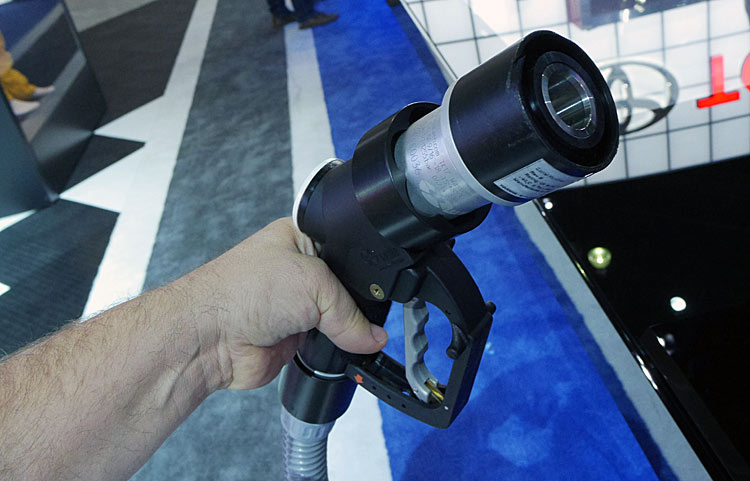|
|
Hydrogen Fuel Cell Distraction  With new technology there is always a group of people willing to be the first to try it. In the late 1980's I was one of the first to plunk down $400 to purchase a bare bones Laserdisc video player. While the machine offered incredible picture quality that exceeded VHS, most people chose to stay on the sidelines. Why?, because at the same time another promising format known as Super VHS that offered a slightly improved VHS picture quality was emerging as possible replacement for VHS. While Laserdisc offered picture quality that was far superior than Super VHS, consumers feared they would be stuck with an orphaned video format. When faced with purchasing or replacing their VHS machines, most consumers stayed the course with VHS. Nobody wants to be left holding obsolete technology. What's Wrong with Hydrogen Fuel Cars? Today, electric cars are facing a similar challenge that was battled between Super VHS and Laserdisc more than a decade ago. This time it appears the battle is being purposely engaged by various auto manufacturers to create doubt as to which technology is better. Those who perform their own research will no doubt come to the conclusion that hydrogen is not the solution. However, most won't bother investigating the claims and choose to stay on the sidelines when choosing a new car. Electric vehicle technology is superior over internal combustion engines in many respects. The cars are quiet with no engine noise, they are faster off the line, cheaper per mile to drive, and they require less maintenance. The only real benefit gasoline cars have is they offer greater driving range between refills, and can be refueled much faster. Owners that possess electric cars tend to obsess over their vehicles. When General Motors refused to renew or sell leased EV1 vehicles their drivers became enraged, forming support clubs to battle General Motors for the right to keep their vehicles. Once a driver has been bitten by the electric vehicle bug they never want to go back to an internal combustion power car. Now that the early adopters market has been satisfied, the next less cautious group is starting to step up to the plate. For the manufacturers this is a horrifying proposition and they will do whatever they can to slow adoption. For the manufacturers the problem with electric vehicles is they do not, and never will generate the same level of profit that a conventional vehicle delivers. Gasoline powered vehicles have many moving parts that require regular maintenance that result in extra revenue from replacement parts. Car dealers also make considerable profit from their service departments. On the other hand electric vehicles do not require much maintenance. There are no oil changes, no tune ups, no fuel injection systems to replace, and no transmissions to rebuild. An electric vehicle is like an iPhone with wheels. It has a battery, a computer, and electric motors. After 20,000 miles my Honda Fit EV has only been to the dealer twice for service, and that was for rotating the tires. If you are an auto manufacturer the most logical way to slow the adoption is to create confusion. They want to cause those customers standing on the fence to steer away from purchasing a new electric vehicle. Once they lose that customer to electric they may never be able reclaim them. Creating confusion is as simple as creating the perception that there is a better mouse trap on the horizon. In this case it is the Hydrogen Fuel Cell vehicle. Toyota, Hyundai, and Honda are all rolling out their fuel cell vehicles at a time when battery electric vehicles are on the verge of a breakthrough that will enable 200 miles of driving range for about $30,000.  The back end of Toyota's Mirai hydrogen car chassis. It contains two pressurized fuel tanks and small energy storage battery that functions as a short term buffer. While a battery electric vehicle is charged from any electrical outlet, a hydrogen fuel cell carries one or more tanks of pressurized hydrogen to feed into the fuel cell. These vehicles are quite expensive to fuel, costing $5 for the gasoline gallon equivalency. Fueling stations are also not very plentiful either. The range is only about 300 miles so owners should expect to find a filling station once a week. Even though drivers gain the performance of an electric vehicle, they have the hassle of seeking out filling stations.  Filling up the fuel cell with hydrogen uses this nozzle to force compressed hydrogen into the fuel tank. In contrast, while most of the current offerings of a battery electric vehicles are limited in range, totaling under 100 miles, they offer the ability to refuel at any electrical outlet. Using a conventional 120 volt outlet a driver can top off a battery electric vehicle overnight. While most electric vehicles are limited in range by design, Tesla offers the Model S with 250 miles of range. It also offers the ability to supercharge to 80% capacity in about a half hour. The technology is already available to build high mileage battery electric cars, but the auto manufacturers choose not to bring them to market in fear it will compete with their internal combustion models. With the exception of Tesla, no other company has a high mileage battery electric vehicle on the market. A week doesn't go by that I am not approached by a passerby in a local parking lot inquiring about my electric cars. People are genuinely interested in the technology. In my home city of Santa Clarita it is not unusual to see a dozen electric and plugin cars during a cross town commute. Sometimes, coincidentally I find myself parking next to another electric car. Electric car penetration is growing, but its growth will be retarded for a few years while the manufacturers confuse the public.  Slim Pickens rides the bomb in the classic film Dr. Strangelove. |